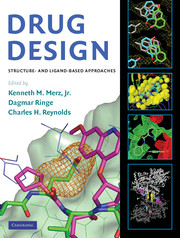Book contents
- Frontmatter
- Contents
- Contributors
- Preface
- DRUG DESIGN
- 1 Progress and issues for computationally guided lead discovery and optimization
- PART I STRUCTURAL BIOLOGY
- PART II COMPUTATIONAL CHEMISTRY METHODOLOGY
- 5 Free-energy calculations in structure-based drug design
- 6 Studies of drug resistance and the dynamic behavior of HIV-1 protease through molecular dynamics simulations
- 7 Docking: a domesday report
- 8 The role of quantum mechanics in structure-based drug design
- 9 Pharmacophore methods
- 10 QSAR in drug discovery
- 11 Predicting ADME properties in drug discovery
- PART III APPLICATIONS TO DRUG DISCOVERY
- Index
- References
10 - QSAR in drug discovery
from PART II - COMPUTATIONAL CHEMISTRY METHODOLOGY
Published online by Cambridge University Press: 06 July 2010
- Frontmatter
- Contents
- Contributors
- Preface
- DRUG DESIGN
- 1 Progress and issues for computationally guided lead discovery and optimization
- PART I STRUCTURAL BIOLOGY
- PART II COMPUTATIONAL CHEMISTRY METHODOLOGY
- 5 Free-energy calculations in structure-based drug design
- 6 Studies of drug resistance and the dynamic behavior of HIV-1 protease through molecular dynamics simulations
- 7 Docking: a domesday report
- 8 The role of quantum mechanics in structure-based drug design
- 9 Pharmacophore methods
- 10 QSAR in drug discovery
- 11 Predicting ADME properties in drug discovery
- PART III APPLICATIONS TO DRUG DISCOVERY
- Index
- References
Summary
INTRODUCTION
With nearly fifty years of rich history of methodology developments and applications (the Hansch article of 1963 is often considered first in the field), quantitative structure/activity relationship (QSAR) modeling is a well-established area of research. As is true perhaps for any computational field, QSAR modeling has been both blessed and sometimes cursed in the literature. In the first volume of the famous book series titled Reviews in Computational Chemistry, Boyd summarized several documented cases when QSAR modeling was instrumental in discovering new drugs of drug candidates in advanced phases of clinical trials. The methodologies used by that time were relatively simple, employing a small number of physical chemical descriptors and statistical methods such as multiple linear regression. QSAR modeling was viewed solely as a tool for lead optimization; that is, it was employed to elucidate the relationship between structure and activity in relatively small congeneric compound series and predict relatively small structural modifications leading to enhanced activity.
Since the late 1980s the field has changed dramatically, fueled by changes in the size, complexity, and availability of experimental data sets of biologically active compounds. These changes have been coincidental with the advances in chemometrics, resulting in a significant increase in the number of chemical descriptors as well as growing implementation of machine learning and advanced statistical modeling techniques available for QSAR studies.
- Type
- Chapter
- Information
- Drug DesignStructure- and Ligand-Based Approaches, pp. 151 - 164Publisher: Cambridge University PressPrint publication year: 2010
References
- 9
- Cited by

